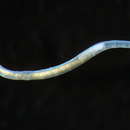Diagnosis
provided by World Register of Marine Species
Original diagnosis by McIntosh (1922: 4): 'Prostomium rudimentary; cephalic region blunt, with bristles on each side. Body definitely segmented, divisible into anterior, middle, and posterior regions and grooved ventrally. Dorsal and ventral bristles with a pear-shaped papilla between them. The stouter anterior bristles present a terminal hook.''
6. Wildlife Scientific Advice, Natural Heritage Division. (2001)
National Recovery Plan for Albatrosses and Giant-petrels. Environment Australia, Canberra.
- license
- cc-by-4.0
- copyright
- WoRMS Editorial Board
Diagnosis
provided by World Register of Marine Species
Diagnosis by Petersen (2000: 496): ''Fauveliopsids with bodies short, comma-shaped to elongate, usually somewhat inflated in middle or towards posterior end, tapering posteriorly, with last segments rudimentary and conspicuously smaller than preceding ones. Adults with 10 to about 90 segments. Body weakly divided into two or three regions recognizable by features of segments and chaetae, or without discernible regions. Segmental boundaries distinct at least ventrally throughout anterior and middle regions, may be less so posteriorly. Cuticle dull, often transversely wrinkled (rugose) or multiannulate, opaque anteriorly, often transparent posteriorly, with one or more types of papillae; some species with cuticular ventral shield in middle and/or posterior segments. Prostomium smooth, bluntly conical, with or without eyespots; pair of densely ciliated nuchal organs as flat patch (not grooved) on either side of prostomium; upper lip bilobed, lower lip entire, between the two a membranous saclike (not flaplike) structure on either side, arising inside mouth and fused to lateral portions of mouth opening, meeting but not joined midventrally; mouth opening anchor-shaped. Peristomium fused to prostomium, finely ciliated, resembling a velvety ring when viewed under a stereomicroscope. Interramal papillae mostly stalked, conspicuous, well developed anteriorly, smaller posteriorly. Chaetae include weakly or strongly curved falcate aciculars; curved, smooth or convexly hispid sigmoid aciculars (Fauveliopsis sp. A of Wolf, 1984; perhaps hirsute, material not seen); and slender, limbate pointed chaetae (capillaries or very slender aciculars). Genital papilla in some (all?) species. Pygidium inconspicuous, with or without papillae, not retractable(?). Habitat.—When known, in gastropod or scaphopod shells or tubular tests of foraminiferans.''
3.
Scarce Ground Beetle Project Newsletter No 2. October 2002. English Nature, Peterborough.
- license
- cc-by-4.0
- copyright
- WoRMS Editorial Board
Habitat
provided by World Register of Marine Species
Known from seamounts and knolls
Stocks, K. 2009. Seamounts Online: an online information system for seamount biology. Version 2009-1. World Wide Web electronic publication.
- license
- cc-by-4.0
- copyright
- WoRMS Editorial Board

